Origin Genesis Review: Triple Titan Terror
by Ryan Smith on April 23, 2013 9:00 AM ESTLetting Titan Spread Its Wings, Cont
Moving on, let’s take a look at 3 of our most intensive games: Battlefield 3, Far Cry 3, and Crysis 3.

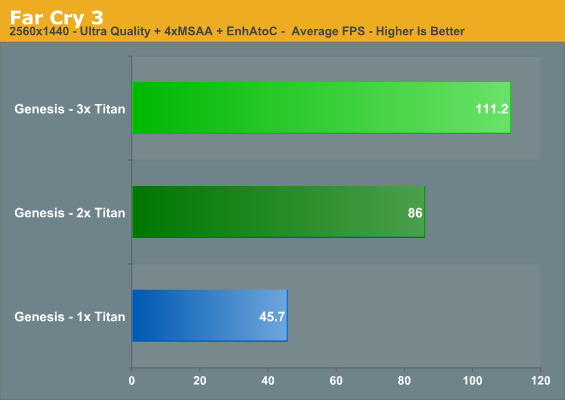
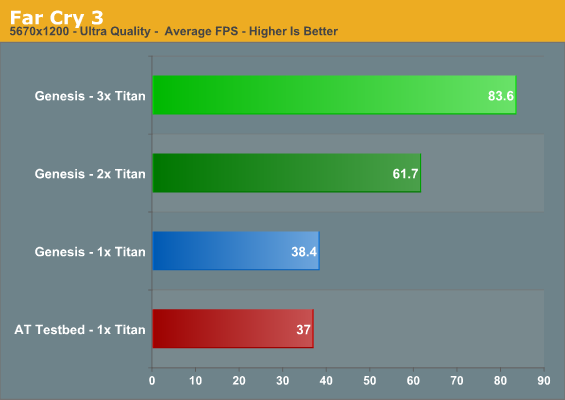
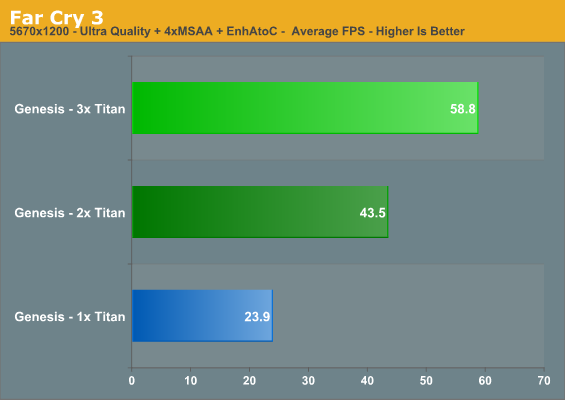
Far Cry 3 is another game that highlights the difficulty in keeping all 3 Titans fed. We have to go to 5760 before a tri-SLI setup isn’t being held back by the CPU. Once we’re there however, additional Titans make a clear difference. At least 2 are required to keep average framerates above 60fps at 5760 without anti-aliasing, and with the AA cranked up even 3 Titans can’t quite crack 60fps. This may be for the best though; for some reason the input lag at 5760 with 3 Titans is especially bad, and this is likely a further artifact of Far Cry 3’s quirks.
At the very least scaling is once again fairly good. At 5760 with AA moving from 1 to 2 Titans improves performance by 82%, and 2 to 3 Titans by another 35%.
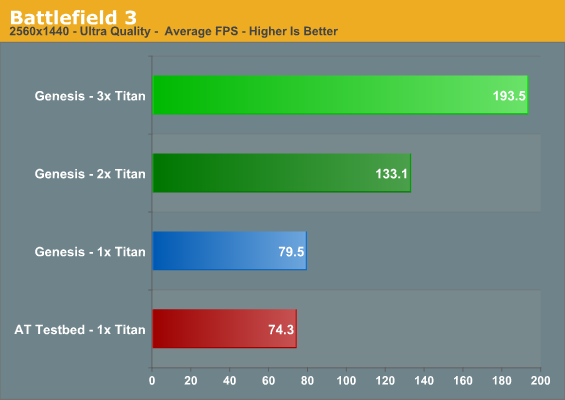
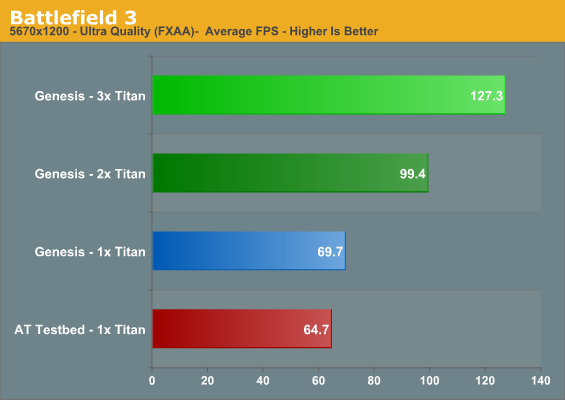
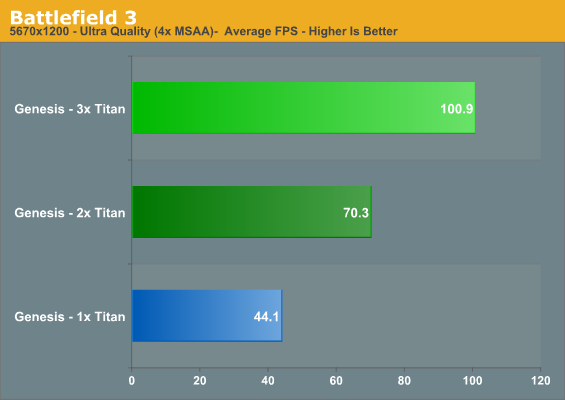
Battlefield 3 isn’t appreciable CPU limited, but it does present something of a scaling issue for Titan. Scaling with 1 display is only 67% for the 2nd Titan, and 45% for the 3rd. And with multiple displays at 5760 with MSAA that becomes 59% and 43% respectively. Oddities aside of scaling being relatively better with the 3rd Titan than the 2nd, even with MSAA we’re seeing an average of 70fps with 2 Titans at 5760, so minimum framerates are still above 30fps. So the practical advantage of the 3rd Titan is limited to minimum framerates, or otherwise doing 120Hz gaming.
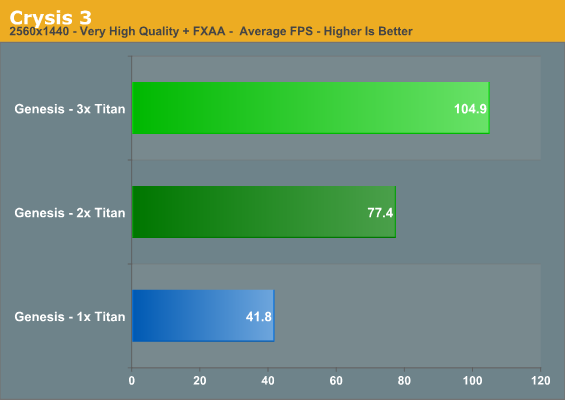
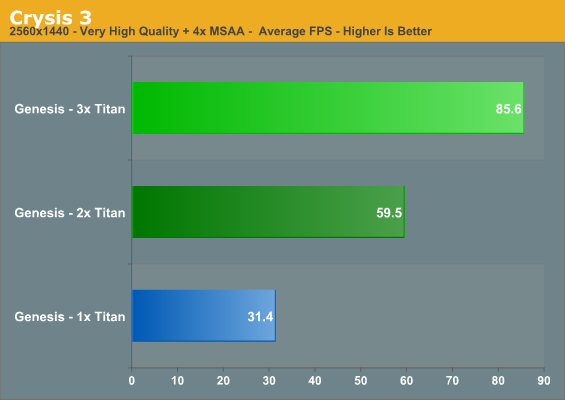
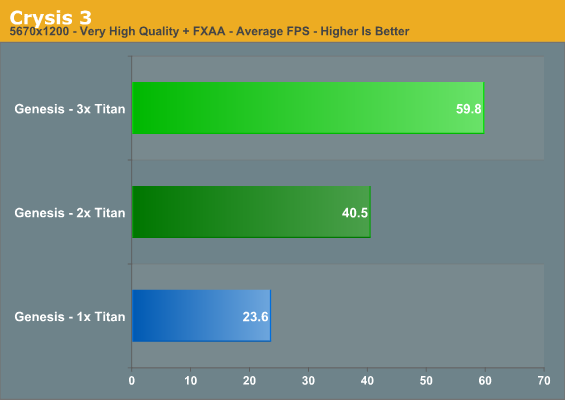
Finally we have Crysis 3, which is first being used here before rolling it into our larger benchmark suite. Taken from the intro level (Post-Human), Crysis 3 was meant to kill GPUs and it shows. 1 Titan can’t break 60fps at 2560 even with FXAA, and 2 Titans are just short if we add MSAA. Move to 5760, and even 3 Titans won’t break 60fps with FXAA. So while the rest of the games in our suite need multi-monitor resolutions to really take advantage of a tri-SLI setup, even 1 2560 monitor can drag a tri-SLI setup back down to earth when it comes to Crysis 3. Even if it’s not game of the year, just as in past years Crysis 3 will move high-end video cards; of that there’s no doubt.
Looking at Titan scaling again, Crytek and NVIDIA have clearly done their homework for single-monitor resolutions. At 2560 with MSAA scaling is 89% from 1 card to 2, and 44% from 2 cards to 3. Unsurprisingly, scaling does taper off at 5760 due to the performance hit of keeping multiple display buffers across multiple cards organized. 1 card to 2 cards is just 72% here, but adding a 3rd card adds another 47% in performance.
Across our 6 games we can see that 3 Titans generally pays off, but a big part of this is using resolutions and settings that can shift as much of the burden onto the GPU as possible. With the exception of Crysis 3 almost everything plays fine on just 2 Titans, with the 3rd Titan necessary to hit 5760x1200 with the best quality settings. On the other hand the fact that even Crysis 3 is almost at 60fps at 5760 with everything short of MSAA turned up is quite a change of pace. NVIDIA told us they wanted tri-SLI Titan to be a no-compromise gaming setup, and indeed they’ve delivered on that.
The only way we’d be able to push a tri-SLI Titan setup harder would either be to use a 2560x1440 surround setup – which admittedly isn’t outside the realm of possibility when we’re talking about pairing it with a $9000 computer – or otherwise going outside the lines and using SSAA on the titles that support it. It may come off as hyperbole, but “I have 3 monitors and the Genesis still isn’t slow enough” was a very real problem putting this article together. To that end it’s surprising that we weren’t CPU limited more often than we were; it’s still a concern, but for the most part in surround gaming the CPU can stay ahead of the GPU, at least if it’s as heavily overclocked as the Genesis’ 4.9GHz SNB-E.










63 Comments
View All Comments
Pontius - Tuesday, April 23, 2013 - link
Ryan, a question for you:I remember that on the first Titan review, it said nVidia did not have OpenCL support in their Titan drivers and that they were working on fixing whatever issues they were having. Do you know if they have since released a driver that supports OpenCL? If not, do you have any info on a target date? If so, will you be benchmarking this (or other) Titan systems with OpenCL?
Thanks.
Ryan Smith - Tuesday, April 23, 2013 - link
Yes, OpenCL support has since been fixed for Titan. We have the results in bench and you should see them in other articles soon enough.Pontius - Tuesday, April 23, 2013 - link
Awesome, thanks!Pontius - Tuesday, April 23, 2013 - link
BTW, Bench appears to be completely broken. No matter what I select to compare, it keeps taking me back to the main CPU bench page.Ryan Smith - Wednesday, April 24, 2013 - link
D'oh.I'll get the web devs on it in the morning. Thank you for pointing that out.
Footman36 - Tuesday, April 23, 2013 - link
120gb SSD, no dedicated sound card and a case that can only accept 120x3 at the top is not going to cut it. Too loud, too hot. Why not use the new Corsair 900. Even though it is not yet available I am sure that Origin could have waited. It will retail at around $350 so not much more than the 800 and has room for 4x120 at the top, 3 x 120 at the front 4 x 120 bottom side and 1 x 140 at the back. Much more sensible cooling options. Would have handled the heat output better reducing load temps and noise. I have GTX 670's in SLI and 3770K all overclocked with a single 140 rad at the back and a triple 120 at the top of my Switch 810, so Origins cooling leaves me meh! And all this for the price of a cheap car! No thanks.7Enigma - Tuesday, April 23, 2013 - link
Ryan,I've seen this before in case reviews and it always confuses (annoys) me. You mention that the manual fans on high are loud, and you post values for the noise at 66% under load, but you don't post the TEMPERATURES of the CPU/GPU at that 66% load. Saying, "At these speeds the Genesis still has plenty of airflow for just about everything, but we would not recommend replicating our 1340W load testing at anything less than full speed since it was at these settings that we hit 81C under full load.", is just not very helpful. We want to know @66% are you now getting close to the limit of components when playing the most demanding game in your arsenal? What about the hard drive, ram, optical drive, etc. that now has to deal with hotter internal temperatures (especially because the top fans have now been forced to work against physics).
I just feel that when numbers are cherry-picked or not fully disclosed (low temps at high fan speeds, and low noise at low fan speeds) a potential buyer doesn't have much helpful REAL WORLD usage and the manufacturer gets put in a better light.
Great review otherwise, I just want to see those extra data points!
Ryan Smith - Tuesday, April 23, 2013 - link
The short answer is no, component temperatures don't get too bad when gaming at 66%. The GPUs never exceeded 62C, and the CPU never exceeded 75C. As for the other components, the SSDs and HDD are in their own bay; the only things of note cooled by the primary chamber are the VRMs and RAM, and the latter doesn't have temperature probes.7Enigma - Wednesday, April 24, 2013 - link
Thank you for the data! Any way you could put that in one of the tables above (or at least mention it in the gaming section)? And do that in the future if similar fan options are allowed?teiglin - Tuesday, April 23, 2013 - link
You accidentally claimed that there are 2000 square meters of silicon in this thing on the power/temps page; that'd be a pretty stunning amount of microchip!